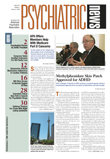Researchers have determined that elderly demented patients taking antipsychotic medications face an elevated risk of death regardless of whether they are taking newer second-generation antipsychotic medications (SGAs) or older first-generation antipsychotics (FGAs).
In April 2005 the U.S. Food and Drug Administration (FDA) announced it was asking drug companies who market SGAs to add a black-box warning to the labels of all SGAs marketed in the United States, cautioning physicians of a higher risk of death from cerebrovascular events (Psychiatric News, May 6, 2005). At that time, however, the FDA noted only that risk of death associated with the older medications was “an important issue for future study.”
A group of researchers at Harvard Medical School's Brigham and Women's Hospital, led by Phillip Wang, M.D., Dr.P.H., an assistant professor of psychiatry, were alarmed about the potential switching of some elderly patients off of SGAs and on to FGAs under an unproven notion that they may be safer.
The Harvard group then sought to define the risk of death in the short term among elderly patients who were prescribed FGAs, compared with the already quantified risk of death associated with elderly patients taking SGAs. The group's report appeared in the December 1, 2005, New England Journal of Medicine.
Wang and his colleagues undertook a retrospective cohort study involving 22,890 patients aged 65 and older who had drug insurance benefits in Pennsylvania and were prescribed an antipsychotic medication between January 1, 1994 and December 31, 2003. Patients receiving benefits under the Pennsylvania Pharmaceutical Assistance Contract for the Elderly (PACE) program were either indigent or “near poor.”
The researchers identified 9,124 patients who began taking an FGA and 13,724 who began using one of the newer SGAs. Patients prescribed the older, less-expensive medications were slightly younger and more likely to be male and non-white compared with those prescribed the newer, more costly drugs.
Patients prescribed the older drugs were less likely to have cerebrovascular disease, dementia, delirium, psychoses, or other psychiatric disorders. Those taking the older medications were more likely to have congestive heart failure, ischemic heart disease, or cancer.
In addition, those taking the older antipsychotics were taking fewer psychotropic medications as well as a lower total number of medications altogether. Those on FGAs were also less likely to be hospitalized or stay in a nursing home in the 180 days preceding the prescribing of their antipsychotic medication.
Within the first 180 days after the antipsychotic was prescribed, 17.9 percent of those prescribed an FGA died, compared with 14.6 percent of those who took an SGA. This difference between the two rates was statistically significant and remained significant even after the team of researchers adjusted for “a large number of potential confounders” such as age, sex, date of first prescription, and a propensity scoring adjustment based on the likelihood of the patient's doctor prescribing FGAs over SGAs or the reverse.
“The greatest increase in the adjusted risk of death for conventional as compared with atypical antipsychotic medications,” Wang and his colleagues said, “occurred with higher doses (i.e., greater than the median) of conventional agents and during the first 40 days after the initiation of therapy.” The differences in the risk of increased death were also greatest “soon after therapy was initiated; the rates of death then began converging in subsequent periods.”
The researchers concluded that, “If confirmed, our results suggest that conventional antipsychotic medications may not be safer than atypical agents and should not simply replace atypical drugs that are stopped in response to recent FDA warnings.”
N Engl J Med 2005 353 2335
